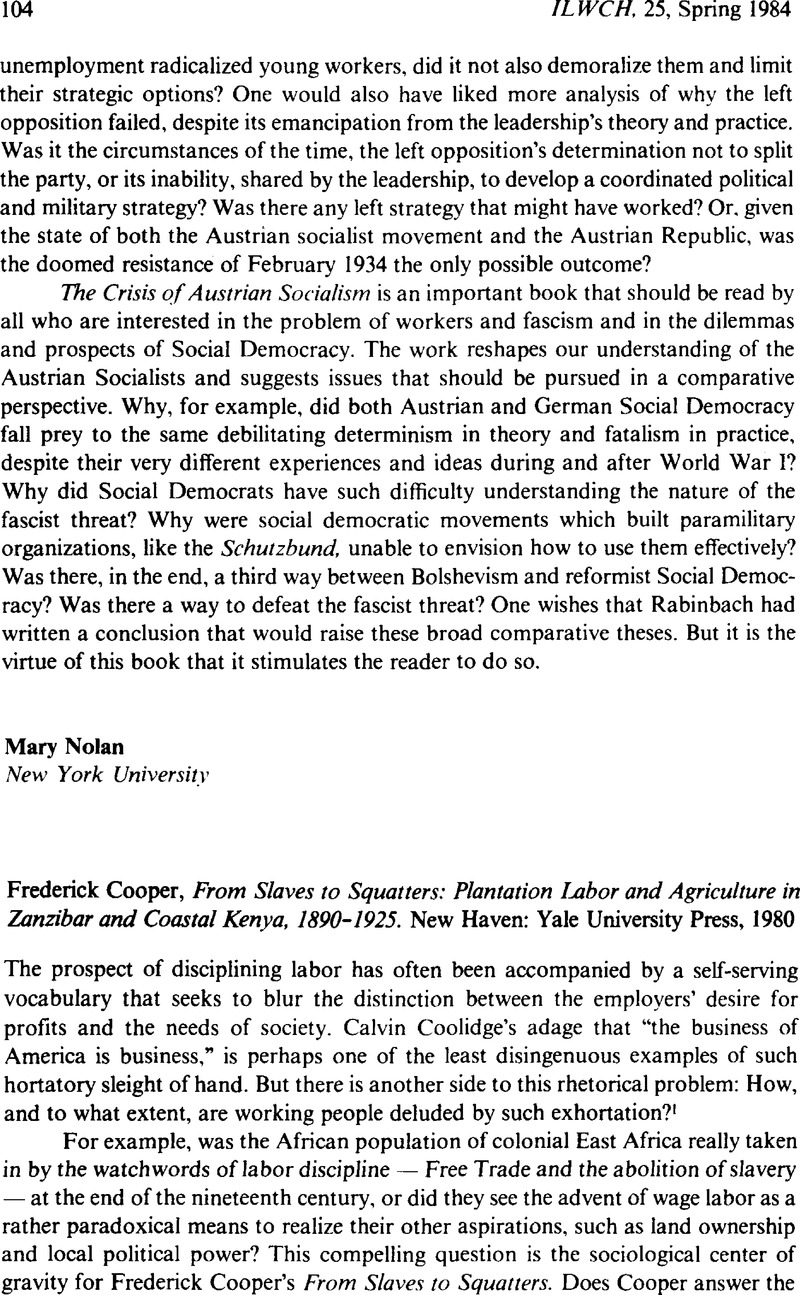No CrossRef data available.
Article contents
Frederick Cooper, From Slaves to Squatters: Plantation Labor and Agriculture in Zanzibar and Coastal Kenya, 1890–1925. New Haven: Yale University Press, 1980
Published online by Cambridge University Press: 16 December 2008
Abstract

- Type
- Book Reviews
- Information
- Copyright
- Copyright © International Labor and Working-Class History, Inc. 1984
References
NOTES
1. For a succinct exploration of this problem, but from the vantage point of the British industrial working class, see: Jones, Gareth Stedman, “Class Expression vs Social Control,” History Workshop, (Fall, 1977), 163–170Google Scholar.
2. For a good example of the modern-day manifestations of this problem see: Nyerere, Julius, “After the Arusha Declaration,” in Ujamaa: Essays on Socialism (Dar es Salaam: Oxford University Press 1968) 144–177Google Scholar; for a less sanguine view of possible solutions to such problems see: Shivji, Issa, “Jiografia ya Umaskini,” in Maji Maji, Namba 15, Julai 1974, 14–17Google Scholar.
3. Cooper, Frederick, From Slaves to Squatters, 71–92, & p. 18Google Scholar.
4. Cooper, , 69Google Scholar; see also Ranger, Terence, Dance and Society in Eastern Africa (Los Angeles: University of California Press), 13–15Google Scholar.
5. Cooper, , 118Google Scholar.
6. Ranger, , 45–76Google Scholar.
7. Ranger, , 40–43Google Scholar.
8. Although beautifully written, Ranger's book can not improve upon the observations of a contemporary of these events, Mzee Chamwenyewe. In 1971 Mzee Chamwenyewe lived in a government funded housing project in Kurasini, Tanzania, just outside Dar es Salaam. He had been a young man on the eve of the First World War. His father had been a caravan leader and purveyor of rubber, ivory and slaves for merchants in Zanzibar, Kilwa and Dar es Salaam. Mzee Chamwenyewe said that he remembered some of the slaves in his household (“Nusu nawakumbuka — Mkatimai, Balagalye, Nyaruambo, Ramu … Kulikuwa na watumwa wengi.”); that these slaves were treated like family members (“… Walikuwa tukitaa na kindugu tu …”); and that the slaves did not flock to the Christian missions after the 1890s as so many others did. Mzee Chamwenyewe's choice of words is rather revealing, however. The use of word kindugu clearly shows that the “kinship” dimension of the master-slave relationship in Chamwenyewe's household did not leave much room for slaves to be “active” kin, since the ki prefix is used here as both a diminutive and as the designation for a thing.
But on the other hand, Chamwenyewe's narrative does reveal that the break-up of the slave system had gone a long way on its own before the timid British edict of 1897. Moreover, other forms of social dependency came under scrutiny and attack during the emancipation period. Women, for example, as individuals and as members of voluntary associations like the Lele Mama societies were not unaware of these liberatory trends. According to Mzee Chamwenyewe, the advent of the Christian missions and emancipation gave women the idea that they could do their work “carelessly” and they could go around with more than one man (“…, wanawake wanakwenda ovyo. Zamani mwanamke mmoja bwana wake in yeye tu — hawezi kwenda kwa bwana mwingine …”). Put another way, women began to say explicitly what they thought their work was worth and that they had a right to choose their husbands.
I am grateful to Abdul Nanji, Professor of Swahili at Cornell University, for permitting to record a cassette of the interview he did with Mzee Chamwenyewe in 1971, and for permission to quote from that interview here: see interview with Mzee Chamwenyewe (Abdul Nanji), Kurasini, Tanzania, 15 January 1971; see also Ranger 86–88.
9. Cooper, , 172Google Scholar; see Wolff, Richard D., The Economics of Colonialism (New Haven, 1974) 44–70Google Scholar.
10. Cooper, , 172Google Scholar.
11. See Uzoigwe, G.N., Britain and the Conquest of Africa (Ann Arbor, 1974) 154–158Google Scholar; see also Ogot, Bethwell A. “Kenya Under the British, 1895 to 1963,” in Zamani (Ogot, B.A. and Kieran, J.A.), Nairobi 1968, 255–289Google Scholar.
12. See Brantley, Cynthia, The Giriama and Colonial Resistance in Kenya, 1800–1920 (Los Angeles) 43–50Google Scholar.
13. Brantley, , 48–50Google Scholar.
14. Cooper, , 57Google Scholar.
15. Ranger, . 24–29Google Scholar.
16. Ranger, . 23Google Scholar; see also Kitching, Gavin, Class and Economic Change in Kenya (New Haven, 1980) 8–24Google Scholar.




